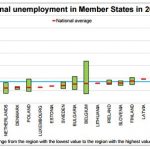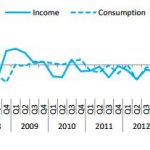The highest and lowest unemployment rates in EU countries
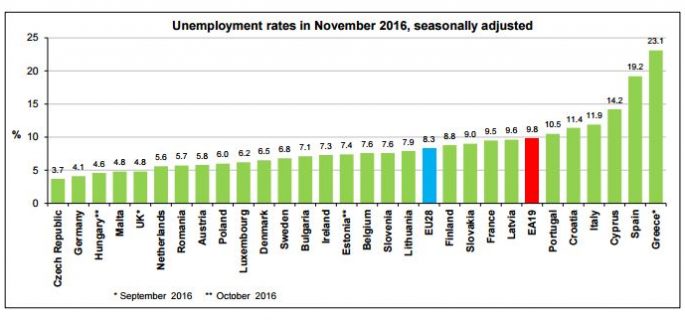
The euro area (EA19) seasonally-adjusted unemployment rate was 9.8% in November 2016, stable compared to October 2016 and down from 10.5% in November 2015. This is the lowest rate recorded in the euro area since July 2009. The EU28 unemployment rate was 8.3% in November 2016, down from 8.4% in October 2016 and from 9.0% in November 2015. This is the lowest rate recorded in the EU28 since February 2009. These figures are published by Eurostat, the statistical office of the European Union.
Eurostat estimates that 20.429 million men and women in the EU28, of whom 15.898 million were in the euro area, were unemployed in November 2016. Compared with October 2016, the number of persons unemployed decreased by 41 000 in the EU28 and by 15 000 in the euro area. Compared with November 2015, unemployment fell by 1.552 million in the EU28 and by 972 000 in the euro area.
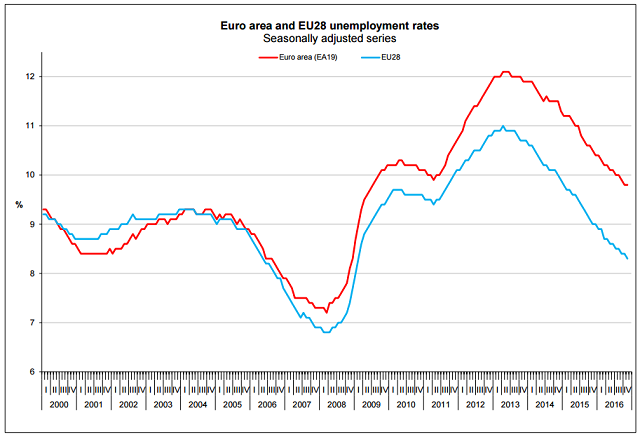
Member States
Among the Member States, the lowest unemployment rates in November 2016 were recorded in the Czech Republic (3.7%) and Germany (4.1%). The highest unemployment rates were observed in Greece (23.1% in September 2016) and Spain (19.2%).
Compared with a year ago, the unemployment rate in November 2016 fell in twenty-four Member States, while it increased in Estonia (from 6.3% to 7.4% between October 2015 and October 2016), Cyprus (from 13.2% to 14.2%), Denmark (from 6.1% to 6.5%) and Italy (from 11.5% to 11.9%). The largest decrease was registered in Croatia (from 15.7% to 11.4%).
In November 2016, the unemployment rate in the United States was 4.6%, down from 4.9% in October 2016 and from 5.0% in November 2015.
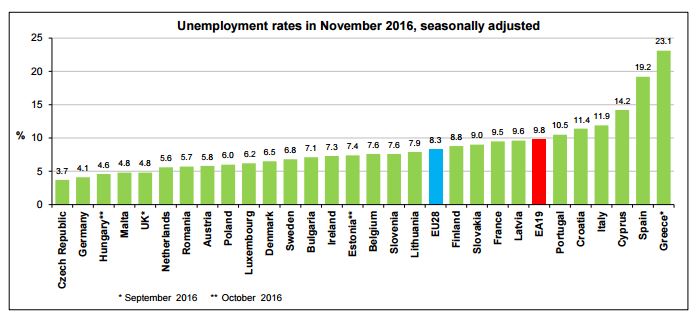
Youth unemployment
In November 2016, 4.280 million young persons (under 25) were unemployed in the EU28, of whom 3.007 million were in the euro area. Compared with November 2015, youth unemployment decreased by 137 000 in the EU28 and by 42 000 in the euro area. In November 2016, the youth unemployment rate was 18.8% in the EU28 and 21.2% in the euro area, compared with 19.5% and 21.8% respectively in November 2015. In November 2016, the lowest rate was observed in Germany (6.7%), while the highest were recorded in Greece (46.1% in September 2016), Spain (44.4%) and Italy (39.4%).
Geographical information
The euro area (EA19) includes Belgium, Germany, Estonia, Ireland, Greece, Spain, France, Italy, Cyprus, Latvia, Lithuania, Luxembourg, Malta, the Netherlands, Austria, Portugal, Slovenia, Slovakia and Finland. The European Union (EU28) includes Belgium, Bulgaria, the Czech Republic, Denmark, Germany, Estonia, Ireland, Greece, Spain, France, Croatia, Italy, Cyprus, Latvia, Lithuania, Luxembourg, Hungary, Malta, the Netherlands, Austria, Poland, Portugal, Romania, Slovenia, Slovakia, Finland, Sweden and the United Kingdom.
Methods and definition
Eurostat produces harmonised unemployment rates for individual EU Member States, the euro area and the EU. These unemployment rates are based on the definition recommended by the International Labour Organisation (ILO). The measurement is based on a harmonised source, the European Union Labour Force Survey (LFS).
Based on the ILO definition, Eurostat defines unemployed persons as persons aged 15 to 74 who:
- are without work;
- are available to start work within the next two weeks;
- and have actively sought employment at some time during the previous four weeks
The unemployment rate is the number of people unemployed as a percentage of the labour force. The labour force is the total number of people employed plus unemployed. In this news release unemployment rates are based on employment and unemployment data covering persons aged 15 to 74.
The youth unemployment rate is the number of people aged 15 to 24 unemployed as a percentage of the labour force of the same age. Therefore, the youth unemployment rate should not be interpreted as the share of jobless people in the overall youth population.
Country notes
Germany, the Netherlands, Austria, Finland, Sweden and Iceland: the trend component is used instead of the more volatile seasonally adjusted data. Denmark, Estonia, Hungary, Portugal, the United Kingdom and Norway: 3-month moving averages of LFS data are used instead of pure monthly indicators
Revisions and timetable
The data in this News Release can be subject to revisions, caused by updates to the seasonally adjusted series whenever new monthly data are added; the inclusion of the most recent LFS data in the calculation process; update of seasonal adjustment models with complete annual data.
Compared with the rates published in News Release 239/2016 of 1 December 2016, the October 2016 unemployment rate has been revised upwards for the EU28 (from 8.3% to 8.4%). Among Member States, rates have been revised by more than 0.1 percentage points (pp) upwards for Cyprus (by 1.8 pp), Poland (by 0.4 pp) and Italy (by 0.2 pp). The unemployment rate has been revised by more than 0.1 pp downwards for Croatia (by 1.2 pp), Belgium (by 0.3 pp), Bulgaria and Portugal (both by 0.2 pp).
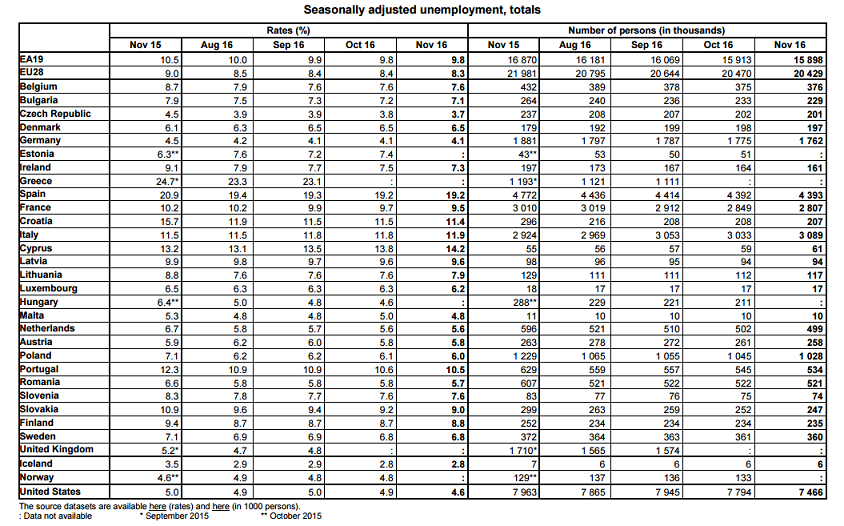
Source: Eurostat










